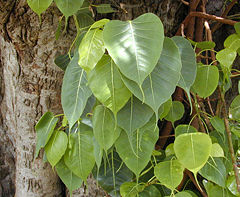Sacred fig
| Sacred Fig | ||||||||||||||
|---|---|---|---|---|---|---|---|---|---|---|---|---|---|---|
 Leaves and trunk of a Sacred Fig.
Note the distinctive leaf shape. | ||||||||||||||
| Scientific classification | ||||||||||||||
| ||||||||||||||
| Ficus religiosa L. |
The Sacred Fig (Ficus religiosa) is a species of banyan fig native to Sri Lanka, Nepal and India, southwest China and Indochina east to Vietnam. It is known by a wide range of local names, such as Bo or pou (from the Sinhalese bo), Bodhi (in Thai Language), Pipal (peepal, peepul, pippala, pimpal, etc.), arali or Ashvastha tree. It is a large dry season-deciduous or semi-evergreen tree up to 30 m tall and with a trunk diameter of up to 3 m.

The leaves are cordate in shape with a distinctive extended tip; they are 10-17cm long and 8-12cm broad, with a 6-10cm petiole. The fruit is a small fig 1-1.5cm diameter, green ripening purple.
The Bodhi tree and the Sri Maha Bodhi propagated from it are famous specimens of Sacred Fig. The known planting date of the latter, 288 B.C.E., gives it the oldest verified age for any angiosperm plant.
This plant is considered sacred by the followers of Hinduism, Jainism and Buddhism, and hence the name 'Sacred Fig' was given to it. Siddhartha Gautama is referred to have been sitting underneath a Bo Tree when he was enlightened (Bodhi), or "awakened" (Buddha). Thus,
Bo Tree is well-known symbol for happiness, prosperity, longevity and good luck. Today in India, Hindu Sadhus still meditate below this tree, and in Theravada Buddhist Southeast Asia, the tree's massive trunk is often the site of Buddhist and animist shrines.
Plaksa
Plaksa is a possible Sanskrit term for the Sacred fig. According to Macdonell and Keith (1912), it rather denotes the Wavy-leaved Fig tree (Ficus infectoria).
In Hindu texts, the Plaksa tree is associated with the source of the Sarasvati River. The Skanda Purana states that the Sarasvati originates from the water pot of Brahma and flows from Plaksa on the Himalayas. According to Vamana Purana 32.1-4, the Sarasvati was rising from the Plaksa tree (Pipal tree).[1]
Plaksa Pra-sravana denotes the place where the Sarasvati appears.[2] In the Rigveda Sutras, Plaksa Pra-sravana refers to the source of the Sarasvati.[3]
Notes
See also
- Sri Maha Bodhi
- Sitala
ReferencesISBN links support NWE through referral fees
- Keith and Macdonell. 1912. Vedic Index of Names and Subjects.
- Plaksa description
External links
Credits
New World Encyclopedia writers and editors rewrote and completed the Wikipedia article in accordance with New World Encyclopedia standards. This article abides by terms of the Creative Commons CC-by-sa 3.0 License (CC-by-sa), which may be used and disseminated with proper attribution. Credit is due under the terms of this license that can reference both the New World Encyclopedia contributors and the selfless volunteer contributors of the Wikimedia Foundation. To cite this article click here for a list of acceptable citing formats.The history of earlier contributions by wikipedians is accessible to researchers here:
The history of this article since it was imported to New World Encyclopedia:
Note: Some restrictions may apply to use of individual images which are separately licensed.

